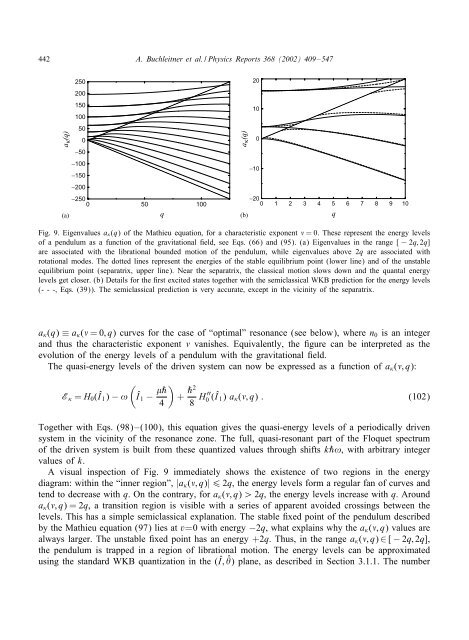Non-dispersive wave packets in periodically driven quantum systems
Non-dispersive wave packets in periodically driven quantum systems
Non-dispersive wave packets in periodically driven quantum systems
You also want an ePaper? Increase the reach of your titles
YUMPU automatically turns print PDFs into web optimized ePapers that Google loves.
442 A. Buchleitner et al. / Physics Reports 368 (2002) 409–547<br />
a κ(q)<br />
250<br />
200<br />
150<br />
100<br />
50<br />
0<br />
−50<br />
−100<br />
−150<br />
−200<br />
−250<br />
0 50 100<br />
(a)<br />
q<br />
20<br />
10<br />
0<br />
−10<br />
−20<br />
0 1 2 3 4 5 6 7 8 9 10<br />
Fig. 9. Eigenvalues a (q) of the Mathieu equation, for a characteristic exponent = 0. These represent the energy levels<br />
of a pendulum as a function of the gravitational eld, see Eqs. (66) and (95). (a) Eigenvalues <strong>in</strong> the range [ − 2q; 2q]<br />
are associated with the librational bounded motion of the pendulum, while eigenvalues above 2q are associated with<br />
rotational modes. The dotted l<strong>in</strong>es represent the energies of the stable equilibrium po<strong>in</strong>t (lower l<strong>in</strong>e) and of the unstable<br />
equilibrium po<strong>in</strong>t (separatrix, upper l<strong>in</strong>e). Near the separatrix, the classical motion slows down and the quantal energy<br />
levels get closer. (b) Details for the rst excited states together with the semiclassical WKB prediction for the energy levels<br />
(- - -, Eqs. (39)). The semiclassical prediction is very accurate, except <strong>in</strong> the vic<strong>in</strong>ity of the separatrix.<br />
a (q) ≡ a ( =0;q) curves for the case of “optimal” resonance (see below), where n0 is an <strong>in</strong>teger<br />
and thus the characteristic exponent vanishes. Equivalently, the gure can be <strong>in</strong>terpreted as the<br />
evolution of the energy levels of a pendulum with the gravitational eld.<br />
The quasi-energy levels of the <strong>driven</strong> system can now be expressed as a function of a ( ; q):<br />
a κ(q)<br />
(b)<br />
<br />
E = H0(Î 1) − ! Î 1 − ˝<br />
<br />
+<br />
4<br />
˝2 ′′<br />
H 0 (Î 1) a ( ; q) : (102)<br />
8<br />
Together with Eqs. (98)–(100), this equation gives the quasi-energy levels of a <strong>periodically</strong> <strong>driven</strong><br />
system <strong>in</strong> the vic<strong>in</strong>ity of the resonance zone. The full, quasi-resonant part of the Floquet spectrum<br />
of the <strong>driven</strong> system is built from these quantized values through shifts k˝!, with arbitrary <strong>in</strong>teger<br />
values of k.<br />
A visual <strong>in</strong>spection of Fig. 9 immediately shows the existence of two regions <strong>in</strong> the energy<br />
diagram: with<strong>in</strong> the “<strong>in</strong>ner region”, |a ( ; q)| 6 2q, the energy levels form a regular fan of curves and<br />
tend to decrease with q. On the contrary, for a ( ; q) ¿ 2q, the energy levels <strong>in</strong>crease with q. Around<br />
a ( ; q)=2q, a transition region is visible with a series of apparent avoided cross<strong>in</strong>gs between the<br />
levels. This has a simple semiclassical explanation. The stable xed po<strong>in</strong>t of the pendulum described<br />
by the Mathieu equation (97) lies at v=0 with energy −2q, what expla<strong>in</strong>s why the a ( ; q) values are<br />
always larger. The unstable xed po<strong>in</strong>t has an energy +2q. Thus, <strong>in</strong> the range a ( ; q) ∈ [ − 2q; 2q],<br />
the pendulum is trapped <strong>in</strong> a region of librational motion. The energy levels can be approximated<br />
us<strong>in</strong>g the standard WKB quantization <strong>in</strong> the (Î; ˆ ) plane, as described <strong>in</strong> Section 3.1.1. The number<br />
q











